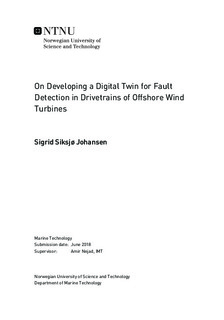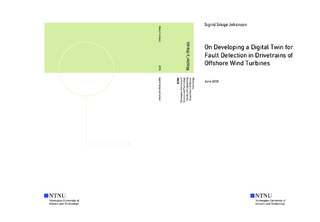| dc.description.abstract | This master thesis considers fault detection of drivetrains in offshore wind turbines through
digital twin approach. A literature review regarding current operations concerning maintenance approaches in today s practices are covered. The main reasons for downtime in
a wind turbine are discussed, and it is argued that faults in the gearbox are a significant
contributor to downtime and should receive serious attention regarding fault detection and
maintenance. Operation and maintenance costs should and could be reduced. There is an
excessive industrial interest to evaluate improved maintenance schemes.
State-of-the-art fault detection in drivetrains is discussed, founded in condition monitoring
and data-based schemes. It is debated that a model-based approach of a digital twin could
be recommended for fault detection of drivetrains. By employing a digital twin fault
detection would be extended to a more diagnostic and predictive maintenance programme,
and costs could be reduced.
A holistic model system approach is considered to be more accurate, and the methodologies of digital twin design are covered. Designing the model introduces several pitfalls
depending on the relevant system, and the advantages, disadvantages and appropriate applications are discussed in extent. For a drivetrain in an offshore wind turbine it is found
that multi-body simulation is advised for the creation of a digital twin model.
A digital twin of a simple drivetrain test rig is made, and different modelling approaches
were implemented to investigate levels of accuracy. Reference values were derived empirically by attaching sensors to the drivetrain during operation in the test rig. Modelling
with a low fidelity model shows a high accuracy, however it would lack several segments
required for a digital twin. The higher fidelity model shows that finding the stiffness parameter proves challenging, due to high stiffness sensitivity as the experimental modelling
demonstrates.
For fault detection by digital twin approach to be reliable, both the digital twin and its
fault modelling have to be reliable. The aim is to have a model reliable to such a degree
that vibration data and fault detection would be performed on the digital twin. Two fault
modelling approaches were performed in this thesis; altering stiffness in the bearing force,
and using an input force vector in the bearing representing the bearing reaction force.
Altering stiffness, based on the limited data attained, would not in this specific case be
applicable, possibly because of high stiffness sensitivity and existing faults. The input
force vector method showed imperfections in output response, and it is recommended to
work further on to correct these flaws. However, this approach have a higher potential
in the aim for digital twin modelling. The input force vector could be implemented in a
real-time, online and dynamic digital twin. This could be done through use of an inverse
method from the equation of motion (EOM) to a dynamic file input in SIMPACK. In this
thesis a stochastic process is proposed, still other approaches could also be effective. | |

